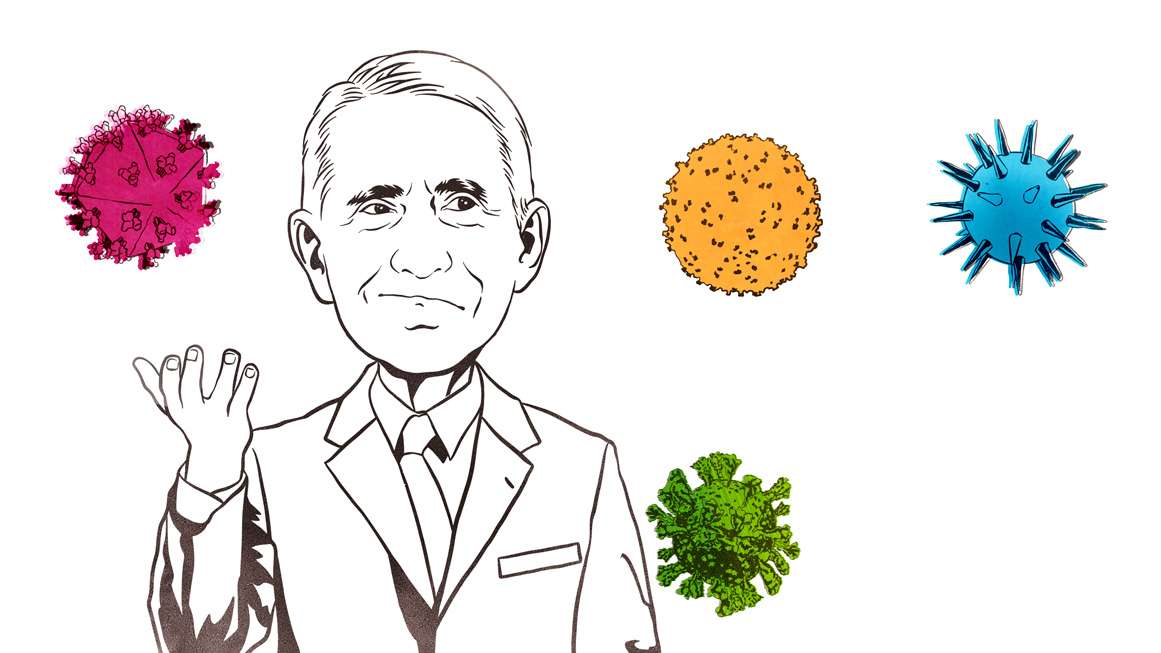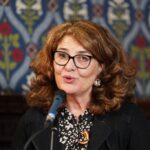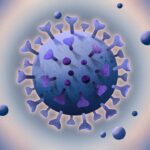In June 2024, Anthony Fauci appeared before the House Select Subcommittee on the Coronavirus Pandemic for a contentious confrontation with congressional Republicans. But it opened on what might have sounded like an amicable note, as the subcommittee’s chairman, Rep. Brad Wenstrup (R–Ohio), played up Fauci’s sainted status: “There were drinks named after you. You got bobbleheads made in your likeness. You were on the cover of Vogue. You threw out the first pitch at a Washington Nationals game.”
Fauci was the closest thing the world of public health had to a rock star. For nearly 40 years prior to the COVID-19 pandemic, Fauci had served as the influential but unassuming director of the National Institute of Allergy and Infectious Diseases (NIAID), a subsidiary of the National Institutes of Health (NIH) housed within the sprawling U.S. Department of Health and Human Services (HHS).
That post made Fauci the federal government’s de facto top pandemic expert across the dozens of agencies—from the Centers for Disease Control and Prevention (CDC) to the Food and Drug Administration to the Office of the Surgeon General—that share responsibilities for preventing and responding to disease outbreaks. Fauci steered the U.S. government’s response to AIDS, Zika, Ebola, and swine flu. He oversaw billions in annual research grants aimed at stopping the next disease outbreak.
When COVID struck, Fauci was the face of public health when public health was all anyone was talking about.
His celebrity also made him a partisan lightning rod. Democrats saw him as a steady, straight-talking scientist who struck a pleasing contrast to a chaotic Donald Trump recommending crank COVID cures in White House press conferences. For many conservatives, he was a hate figure responsible for locking down the country without regard for civil liberties or collateral damage. But by that June 2024 congressional hearing, Fauci was at the center of a new array of controversies.
In 2023, the incoming Republican House majority had reorganized the coronavirus subcommittee to investigate the origins of the COVID-19 pandemic. The information they’d uncovered, supplemented by years of dogged investigative journalism, was damning for Fauci and his agency.
Fauci had long denied his agency had ever funded controversial gain-of-function research at the Wuhan Institute of Virology (WIV) in Wuhan, China, where the COVID-19 pandemic originated. But weeks before Fauci’s testimony, a senior NIH official admitted that the NIAID had funded such research. Days later, President Joe Biden’s administration would strip EcoHealth Alliance—the nonprofit that the NIAID had paid to do that gain-of-function research—of its federal funding, citing the organization’s lack of transparency and oversight failures at the WIV.
Soon after, the select subcommittee revealed that Fauci’s senior scientific adviser, David Morens, told EcoHealth scientists in emails that Fauci would “protect” the group from public scrutiny about the pandemic’s origins and that Morens could pass any needed communications from EcoHealth to Fauci via a private back channel that was safe from public records requests.
The day of Fauci’s testimony, the Harvard- and MIT–affiliated biologist Alina Chan argued in The New York Times that a lab leak at the WIV was the probable cause of the COVID-19 pandemic.
Together, the revelations painted a picture of Fauci as a dissembling, denying, power-grabbing bureaucrat who repeatedly used slippery arguments to dodge public oversight of a controversial, high-risk agenda—an agenda that may have led to the very pandemic his job was to prevent.
Fauci argued it was all much ado about nothing. At the hearing, he said the gain-of-function research the NIAID had funded in Wuhan wasn’t of concern and couldn’t have sparked the pandemic; that he had no back channel with his senior scientific adviser, who he didn’t even work that closely with; and that while a lab leak wasn’t a conspiracy theory, he couldn’t be expected to know everything that happened in China. His story was that he had acted in good faith, in the name of science, and that he wasn’t culpable.
Yet when one considers Fauci’s record and the accumulated evidence about a lab leak origin of COVID-19, it is hard to avoid the conclusion that he is probably at least partially culpable for the pandemic itself and actively worked to obscure that fact. As Richard Ebright, a Rutgers University molecular biologist and fierce Fauci critic, says of the series of choices that led to dangerous pandemic research being conducted in Wuhan with U.S. tax dollars: “There are few decisions that are so centrally linked to a single person and that person’s pathologies, and that person is Anthony Fauci.”
We may never know the full story of the pandemic’s origin. But if this were a bureaucratic whodunit, the most likely suspect would be Fauci. COVID-19 was Fauci’s pandemic.
Pushing Risky Research
Prior to COVID-19, Fauci had long supported funding pandemic research that other scientists found risky, if not downright dangerous.
In 2005, as NIAID director, he praised researchers who’d used a grant from his agency to resurrect the virus that had caused the Spanish flu pandemic. Better understanding that virus would help prevent future diseases, he argued. “The certain benefits to be obtained by a robust and responsible research agenda aimed at developing the means to detect, prevent and treat [future pandemics] far outweigh any theoretical risks,” he said in an October 2005 statement co-authored with then–CDC Director Julie Gerberding.
This wasn’t a universal opinion at the NIAID. The agency’s chief scientist described this approach to pandemic prevention as “looking for a gas leak with a lighted match.”
Fauci would continue to praise and fund this kind of research. In 2011, researchers at the University of Wisconsin and at Erasmus University Medical Center in the Netherlands managed to manipulate the virus H5N1 (which had been responsible for a 2004 bird flu epidemic in Asia) to transmit between mammals, a “gain of function” for a virus that had heretofore only been able to pass from infected birds to humans. One of the researchers involved in the work would say the enhanced pathogen they’d created was “very, very bad news” and “probably one of the most dangerous viruses you can make.” Fauci was more sanguine, telling The New York Times that “there is always a risk. However, I believe that the advantages outweigh the disadvantages.”
When the influenza research community implemented a temporary halt on gain-of-function research in response to the H5N1 experiments, Fauci reluctantly agreed to it as a way to appease public opinion. He still maintained that the potential of this research to prevent the next pandemic far surpassed any potential “theoretical risks” it may pose.
The early 2000s saw deadly outbreaks of bird flu and severe acute respiratory syndrome (SARS), as well as the anthrax mailings following the September 11 attacks, which brought both the public health and national security sectors’ attention to “biosecurity” threats.
At the same time, researchers were rapidly advancing their ability to create and manipulate viruses in the laboratory. This presented the possibility of developing new vaccines, treatments, and methods of pest control. However, it also raised concerns about the accidental release of a new pandemic from a lab.
President George W. Bush’s administration commissioned reports in the mid-2000s on how “dual-use research of concern” could be subjected to a risk-benefit analysis. Despite this, Fauci consistently argued against the notion that their agencies should be subject to additional safeguards when funding risky research on pandemic pathogens.
“It’s fair to say that NIH always leans towards ‘more science, less regulation.’ This was certainly evident in this debate,” said Gregory Koblentz, a biosafety expert at George Mason University who has long been involved in discussions about regulating dual-use research.
While there are valid reasons to be cautious about regulating scientific research, the situation changes when the government is funding the research. Matt Ridley, a science writer, suggests that government funding is a significant part of the issue, as profit-seeking private sectors would avoid the type of research being conducted by EcoHealth Alliance in Wuhan. The chances of such research identifying the next pandemic virus and developing a profitable vaccine or treatment are too low for even the most optimistic venture capitalist.
Furthermore, there was the potential downside of a laboratory accident. In 2014, a series of safety lapses at U.S. government labs highlighted this risk, including incidents of potential exposure to live anthrax samples, accidental contamination of bird flu with deadly H5N1, and the improper storage of smallpox vials capable of infecting individuals.
To address these concerns, President Barack Obama’s administration halted federal funding for gain-of-function research in 2014 and began developing a regulatory framework for assessing these experiments. This led to the creation of the P3CO framework in 2017, which aimed to evaluate grant proposals involving research on known pandemic pathogens or those that could create or enhance such pathogens.
Despite the introduction of the P3CO framework, the NIH had significant autonomy in determining which grant proposals would undergo department-level risk-benefit analysis. This allowed Fauci and NIH Director Francis Collins to bypass the oversight process by choosing not to forward proposals to HHS for review.
During Fauci’s testimony in June 2024, he claimed to have approved every grant funded by the NIAID but admitted in a 2022 deposition that he may have made exceptions to the gain-of-function research pause. This raises the possibility that Fauci approved the work conducted by EcoHealth Alliance in Wuhan, which some speculate may have played a role in the origin of the COVID-19 pandemic.
EcoHealth Alliance, led by Peter Daszak, received a substantial NIAID grant in 2014 to conduct research in China, including sequencing and experimenting on virus samples. Critics have questioned the efficiency of this research in identifying potential pandemic-causing viruses among the vast array in nature. In 2016, EcoHealth disclosed that it was involved in concerning research. In its progress report to the NIAID, EcoHealth outlined plans to develop “chimeric” viruses by combining spike proteins from SARS-like coronaviruses found in the wild with the backbone of a known SARS virus. These viruses were intended to infect “humanized” mice, genetically modified animals with human lung cells, to assess the potential pandemic risk. Despite the biosafety concerns at the WIV, EcoHealth proposed to conduct the research there, violating the gain-of-function pause and P3CO framework guidelines. The NIAID program officer raised concerns about the research, as it appeared to breach the pause on gain-of-function studies. EcoHealth defended its work by claiming that the viruses they were working with were unlikely to infect humans due to genetic differences from the original SARS virus. However, the pause policy did not require prior evidence of infectivity in humans. The NIAID ultimately allowed EcoHealth to continue its research under the condition that the chimeric viruses did not show higher growth rates than natural variants. Subsequent experiments revealed increased viral growth and pathogenicity in humanized mice, which EcoHealth failed to report promptly. Despite these violations, the NIAID renewed EcoHealth’s grant for another five years, leading to further dangerous research proposals. These actions, along with the failure to report to the P3CO committee, may have contributed to the emergence of the COVID-19 pandemic. According to investigative journalist Emily Kopp, evidence suggests that Peter Daszak, the EcoHealth president, had plans to create viruses similar to SARS-CoV-2 with capabilities not found in naturally occurring coronaviruses. These features would enable the viruses to infect and spread more easily in humans.
Kopp’s findings from Freedom of Information Act (FOIA) requests revealed that Daszak and his collaborators attempted to conceal the origin of these novel viruses by omitting the names of Chinese researchers from their proposals for the DEFUSE project. Initial drafts of DEFUSE indicated that the research was to be conducted in Wuhan due to lower biosafety standards, which were seen as cost-effective.
Although the DEFUSE proposal was rejected by DARPA, there is speculation that Chinese researchers may have secured separate funding for similar work. It is also suggested that EcoHealth may have used NIH funding for these experiments, as there was significant overlap between their proposals.
Richard Ebright, a prominent biosecurity expert, believes that the evidence from EcoHealth’s research reports and proposals points to the Wuhan Institute of Virology as the likely origin of the COVID-19 pandemic. He asserts that the timeline and nature of the research align with the emergence of the virus.
The debate surrounding the origins of COVID-19 has been clouded by deliberate efforts to conceal information. Chinese officials have obstructed investigations into the Wuhan Institute of Virology, and key data and materials have not been made public. Dr. Anthony Fauci and NIAID-funded scientists have worked to downplay the possibility of a lab leak, dismissing such theories as conspiracies.
Private communications released by a House subcommittee investigation reveal inconsistencies in public statements made by prominent scientists regarding the origins of the virus. Despite privately acknowledging the plausibility of a lab leak, some researchers publicly denied this possibility in influential publications.
The selective disclosure of information and efforts to shape the narrative surrounding the pandemic have raised questions about transparency and scientific integrity. The true origins of COVID-19 may remain elusive, as key evidence remains hidden or obscured by political and scientific interests. He stated that Fauci was trying to “protect” Daszak. Morens, in a series of emails, advised Daszak to use a personal email account to avoid Freedom of Information Act requests, openly admitted to deleting emails to avoid FOIA scrutiny, and discussed hiding information from records requests through deletions and strategic misspellings. Morens also mentioned having a “backchannel” to Fauci and assured Daszak that there was no need to worry about FOIAs. When questioned about Morens’ comments at a hearing, Fauci denied having substantial discussions about EcoHealth with Morens.
Fauci’s defense is that he oversaw a large agency that distributed billions in grants, making it challenging to monitor every program and project. However, this admission suggests administrative negligence and a failure in oversight protocols. The risky research supported by Fauci did not prevent the pandemic, as evidenced by the emergence of COVID-19. It is likely that Fauci promoted dangerous research that led to a deadly viral pathogen escaping from the lab, which he attempted to cover up.
Throughout the pandemic, Fauci advocated for strict public health measures, despite admitting that social distancing guidance was based on guesswork. The restrictions imposed during the pandemic, such as lockdowns and mask mandates, were largely ineffective. Fauci’s prominent role in the pandemic highlights the risks of concentrating power in one individual and blindly following their directives.
The article was originally titled “Fauci’s Pandemic” and raises questions about Fauci’s handling of the pandemic and the effectiveness of the measures he endorsed. Please rewrite this sentence.
Source link





